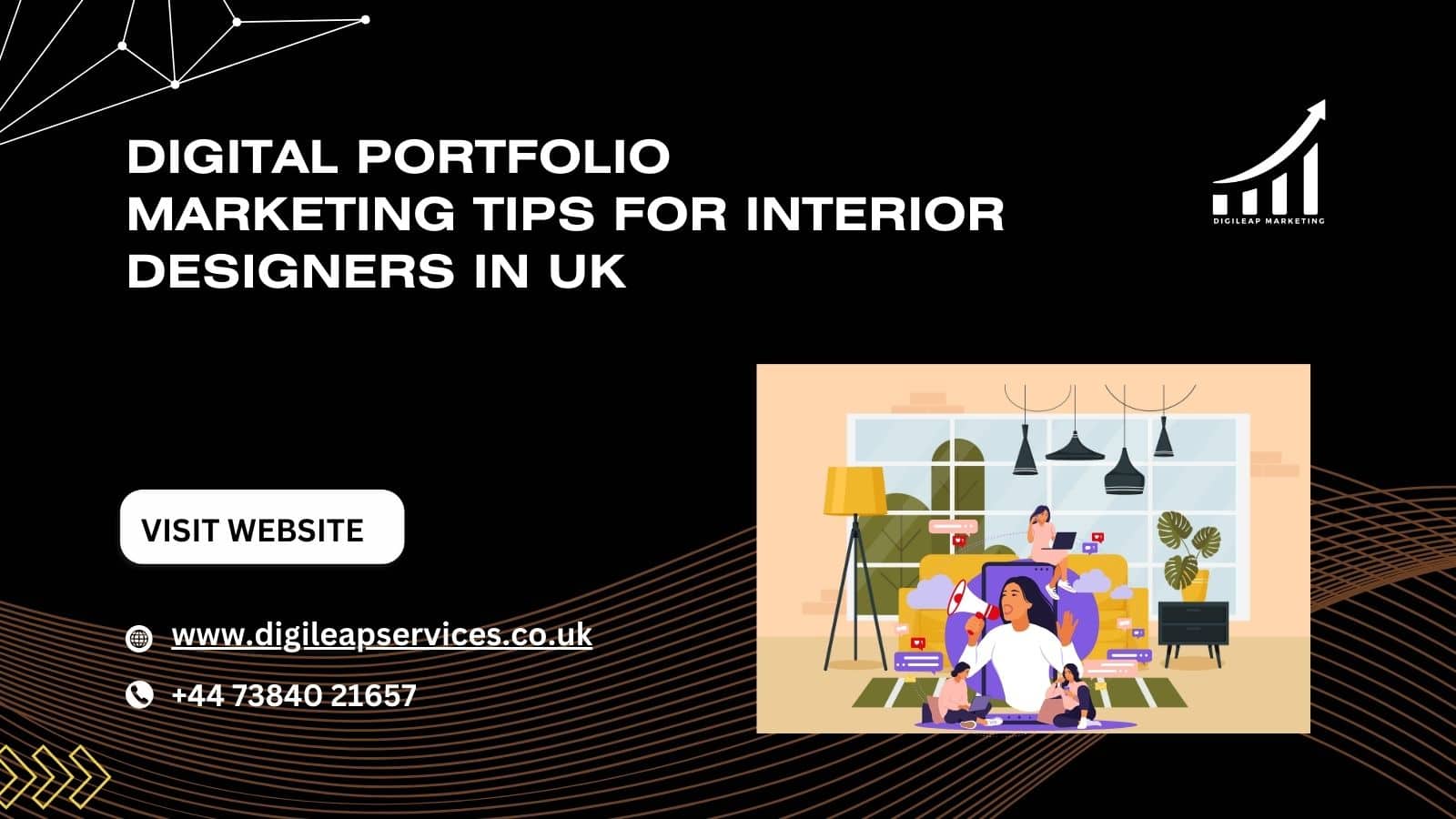Digital Portfolio Marketing Tips for Interior Designers in UK
Let’s face it—being an interior designer in the UK isn’t just about mood boards and paint swatches anymore. These days, if you’re not online, you’re invisible.
That’s where your digital portfolio comes in. It’s your silent sales tool. Your shop window. The thing that says, “Hey, here’s what I do, and here’s why you’ll love working with me.”
But here’s the thing—not all digital portfolios are created equal. Some are just a few images slapped on a page. Others? They tell a story. They build trust. They turn curious clicks into paying clients. Which kind do you want?
In this guide, we’ll walk through practical, no-fluff ways to polish your digital portfolio. Real tips you can use—whether you’re just starting out or already juggling five projects. And if you need help getting found online, Digileap might be worth a look. But more on that later.
1. 🔍 Make Your Work Shine—Visually & Emotionally
1.1 Don’t Show Everything. Just Show the Right Stuff.
Ever walked into a room that had too much going on? Same thing happens in portfolios. You don’t need to show every project—just the ones that make people stop scrolling.
Pick 6–10 pieces that reflect your style. Residential. Commercial. Eco-chic. Whatever your lane is, stay in it and own it. Let people see your vibe right away.
1.2 Your Photos Matter More Than You Think
No surprise here—images are everything. A single bad photo can make great work feel… meh. Invest in a photographer if you can. If not, use natural light and tidy framing. Clean lines, soft shadows, a little editing? Game-changer.
1.3 Don’t Just Show—Tell
Anyone can post a photo. But telling the story behind it? That’s where you stand out.
Instead of “Living Room, 2023,” try something like:
“The client wanted warmth and calm after a stressful move. We kept the palette neutral, added layered textures, and opened up the space to make it feel like a hug.”
People connect with stories, not specs.
2. 📈 Help People Find Your Work (Without Sounding Like a Robot)
You’ve got great work—that’s a given. But what if no one’s seeing it? That’s where search engine stuff (yep, SEO) steps in. It sounds boring, I know. But it doesn’t have to be complicated.
2.1 Keywords, But Make Them Disappear
Let’s say someone in London types “modern interior designer UK” into Google. If your site doesn’t whisper those words in the right spots, Google won’t show it. But here’s the thing—you don’t need to jam keywords into every sentence.
Slide them in naturally, like this:
“As a London-based interior designer, I focus on calming, clutter-free designs that feel like home.”
There. That’s it. Use digital portfolio, eco-conscious design, and interior designer UK where they fit. If it sounds forced? Cut it.
2.2 Ask People to Do Something—Clearly
Someone likes your style. They scroll through your work. Then… nothing. They click away.
Not because they didn’t like you. But because you didn’t tell them what to do next.
Your job? Make that next step obvious:
“Let’s talk about your space.”
“Curious what this might cost? Get a quote.”
“Download my free ‘Room Refresh Checklist.’”
Think of your CTA like a nudge, not a pitch. Keep it light, friendly, and clickable.
2.3 Know What’s Working (So You Can Do More of It)
You don’t need to become a data nerd—but a quick peek at Google Analytics can tell you loads. What pages are people spending time on? Which projects do they ignore?
If everyone clicks on your Scandi-style kitchen makeover but skips the dining room reno? Time to give the kitchen more love.
Knowing what your audience responds to means you can give them more of that.
3. 📣 Trust Wins Every Time—Here’s How to Build It
You’ve probably heard the phrase “social proof.” It’s just a fancy way of saying: “Show people you’re legit.” If strangers trust you, new clients will too.
3.1 Let Others Do the Talking
A good testimonial feels like a friend giving you a heads-up:
“Hey, we hired this person and they were incredible.”
So go beyond the bland reviews. Ask clients why they chose you, what they loved, and how they felt after the job.
Here’s an example:
“We didn’t think anyone could make our odd-shaped attic usable, but [Your Name] made it our favourite space. Now we practically live up there.”
Stick those quotes under each project. That’s where they’ll matter most.
3.2 Social Media—Show Up, But Stay You
You don’t have to be everywhere. You don’t even have to post daily. But a few posts a week? That helps.
Share a corner of your latest project. A colour palette you’re loving. A quick tip, like “Add one black object to every room for contrast.” Easy, right?
Instagram and LinkedIn are great platforms. Hashtags like #InteriorDesignUK or #CalmSpaces help people discover you. But don’t go hashtag wild—keep it simple.
And honestly, if planning content stresses you out, tools like Buffer or Later let you batch and schedule posts in one go. Set it and forget it.
3.3 Don’t Be Afraid to Team Up
You know what? Working with other creatives just works. It’s way better than going it alone. Local furniture makers, photographers, even that quirky lighting designer down the street—partnering with them can seriously stretch your reach.In today’s design world, a strong online portfolio isn’t optional—it’s essential.
Let’s say you’ve got a custom dining table from a local carpenter in one of your projects. Don’t just mention it—shout them out. Tag ’em on Instagram. Drop their name in your blog. They might just share it with their followers too. Boom—free exposure.
And hey, if you’ve got the energy, pitch a quick tip to a home improvement blog or do a short “how I styled this space” video. Doesn’t need to go viral. You don’t need 10,000 followers—you just need the right ones to notice.
4. ⚙️ Make Your Website Easy to Use (So They Stick Around)
You know that feeling when you walk into a room and immediately feel at ease? That’s how your website should feel.
If it’s clunky, slow, or confusing, even the best work won’t save it.
4.1 Make It Fast and Mobile-Friendly
People browse on their phones. In fact, over 60% of global website traffic now comes from mobile devices (Statista). If your portfolio doesn’t load quickly or fit their screen properly, most won’t wait.
Use a simple layout. Limit big file sizes. And always check how it looks on mobile. Little tweaks = big difference.
4.2 Keep Navigation Super Simple
Nobody wants to click through five tabs just to see your work. Stick to the basics:
“Home”
“My Work”
“About Me”
“Let’s Talk”
Add a button or link on every page that leads to your contact form. Keep that form short. Just name, email, and a space to say what they need. That’s enough.
Bonus tip: avoid pop-ups. They annoy more than they help.
4.3 Update It Like You Mean It
Your site isn’t a one-and-done deal. Set a reminder every couple of months to refresh something—new photos, updated captions, even swapping in a recent testimonial.
It keeps things feeling alive and shows potential clients that you’re active, not MIA.
5. 🌿 Show That You Care About More Than Just Style
More and more clients these days aren’t just after good looks—they care about the story behind the space too. If you’re even slightly into sustainable design, don’t keep it to yourself. Seriously, talk about it.Keep your digital portfolio updated, authentic, and easy to navigate to stay top of mind.
5.1 Tell the Story, Not Just the Specs
Did you dig up some old wood from a salvage yard? Use eco-paint that doesn’t smell like chemicals? Maybe you sourced that fabric from a small UK artisan? Mention it. People love that stuff.
You’re not giving a lecture—you’re just letting them in. Try something like:
“We found these vintage chairs at a second-hand shop, gave them a little TLC, and covered them in natural linen. Saved money and the planet—win-win.”
It’s those little stories that make your work memorable.
5.2 Write Something Helpful (But Keep It Short)
Blogging sounds scary, but it doesn’t have to be. Write what you know—just a few paragraphs. Think:
“3 Easy Swaps for a Greener Living Room”
“How to Choose Eco-Friendly Paint (That Actually Looks Good)”
Not only does this help your audience, but it builds trust. And Google likes it too.
5.3 Work with Like-Minded Brands
Feature sustainable suppliers in your digital portfolio. Tag them. Link to them. Then, reach out and say, “Hey, I featured your work—want to share it?”
That’s how you create visibility without paying for ads. Just real connections.
🏁 Conclusion – Wrap It All Up
So what’s the real takeaway right here? Your virtual digital portfolio isn’t only a bunch of pix—it’s your voice while you’re no longer around to speak for yourself. It’s how humans experience you, figure out your vibe, and decide in case you’re someone they’d need out of their space.
Sure, visuals count. A lot. But let’s be sincere—it takes more than pretty photos. You need a bit of story, a piece of soul, and a clear way for folks to go from “Oooh, I love this” to truly attaining it.
And while you hold it human—tell mini-memories, deliver useful context, and display what you surely care about—you’re now not simply filling a website. You’re building trust. The right kind of people will feel it.
And hey, if this digital marketing stuff makes your brain hurt (you’re not alone), Digileap can totally help out without stepping on your creative freedom.
TL;DR – No Time? Here’s the Quick Scoop
Don’t dump every project—pick the best and make them shine.
Use crisp photos and short stories behind each space.
Add real keywords like interior designer UK and digital portfolio—but keep it natural.
Show real reviews and behind-the-scenes stuff on social.
Keep your site clean, mobile-friendly, and updated.
Talk about eco-friendly choices if that’s your thing.
And most of all—be real. Clients want to work with someone who feels human.
You don’t need to do everything at once. Just pick one idea and start there. You’ve got this.

